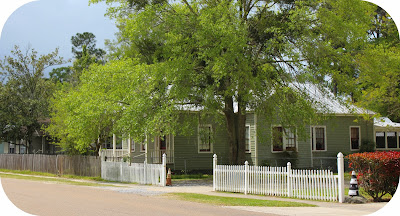Sunday, March 31, 2019
Picket Fences of Madisonville
Picket fences are an American staple, and no where can one find such a rich variety of picket fences as the ones in Madisonville. Some of them are quite old. Here are some photographs. Click on them to make them larger.
Saturday, March 30, 2019
Boats In Color
Here's a photo of the steamer "Ozone," reportedly the fastest steamer in Southern waters, serving New Orleans, Mandeville, and points along the Tchefuncte River. Click on the image to make it larger.
The
Susquehanna, one of the favorite ways to cross Lake Pontchartrain from
New Orleans to the north shore in the early 1900's. Click on the image
to make it larger.
The ever-popular steamer Josie approaching Covington docks via the Bogue Falaya River.
Columbia Schooner Landing, Covington
Friday, March 29, 2019
100 Years Ago This Week
What was going on 100 years ago this week? CLICK HERE for a link to the St. Tammany Farmer of March 29, 1919. The link is provided by the Library of Congress and its Chronicling America service.
Click on the sample images below to see larger versions.
Click on the sample images below to see larger versions.
Town Boosters
Personal and Local News
Slidell To Build Memorial Building
New Bath Houses at Sulphur Springs Beach
Weddings
Thursday, March 28, 2019
Horses Are An Important Part of St. Tammany Activities
Horse breeding, raising and racing have all had an illustrious history in St. Tammany Parish. From saddle horses to thoroughbreds and from hunters/jumpers to polo games, local horse enthusiasts have enjoyed competing, showing, and trail riding all throughout the area.
Area Enjoys Impressive Credentials For Horses
Say "country" and people visualize horses grazing leisurely in lush green pastures. Horses in St. Tammany Parish, however, are big business, with the competition and facilities committed to prove it.
Among the numerous types of growth being experienced by the northlake area, the thoroughbred, quarterhorse and other kinds of equestrian interests are turning heads and winning big money for owners.
The Covington area, especially around Folsom, boasts the second highest density population of horses in the nation, with only Lexington, Kentucky, ahead of it. Almost every month, a new horse breeding and training operation is announced, built or honored dealing with a wide variety of horse breeds.
A large 50 acre Arabian farm was recently developed nearby, and the huge Morgan horse farm recently opened, accompanied by more and more new Saddlebred and Quarter Horse ranches. New breeders are coming in as far away as Texas and Florida, impressed by the quality of St. Tammany's horse breeding activity. The landscape is dotted with stables, race tracks, training arenas and show arenas.
Nearly every month has a competition and showing of horses at the local livestock exhibit showbarn, with people coming from several nearby states to take part. The state of Louisiana won over $12 million in prizes in Breeder Awards this past year in thoroughbred and quarter horse shows, said Barbara Grille of Latter & Blum's Folsom real estate office.
She has been compiling statistics on the surging horse industry, seeing quite an upturn in activity and planning. "The trend is towards cooperative facilities," she said, "where two or three smaller farms share common training equipment and arenas."
She cited growing interest in condominium and country club developments, such as the Folsom Training Center, where smaller acreage and fewer horses are used, but the quality of the horses is higher.
Each breeder affiliates with the others in his particular area of interest, of course, bringing together owners from a wide area. There are parish groups, also, that promote and encourage the horse industry as a whole. The parish is even well represented in the Hunter-Jumper category and once housed the Official State Equestrian Team.
While some horse breeding and training centers can be found in Madisonville, Mandeville and near Abita, most of the activity lies around Folsom, Lee Road, Bush and Old Military Road, scenic rolling hills with long wooden fences marking off the pastures and paddocks.
The numbers tell of the growth; in 1961, there were only 142 Louisiana-bred foals reported, and in 1969, this had increased to 609. By 1982, however, that number had elevated to 2350 foals born, with St. Tammany Parish the leader.
One farm manager said that all kinds of people are getting into the horse business now, and while there have been a lot of bigger farms starting up, most of the activity has been with families moving in and deciding to get a horse or two.
Part of the appeal of the horse industry is, not only its tendency to break even financially, and in some cases make a lot of money, but there are special tax incentives from the state as well. The parish is well represented by top name studs which bring impressive fees, proven winners who are in great demand across the nation.
Some of the farms are specializing in particular breeds and keying into markets that have only recently developed in St. Tammany.
All in all, horse lovers have found the area a highly congenial place to settle in, breed, raise and train horses of every persuasion, for fun, for tax deductions and even for a handsome profit.
If the trend continues, then Louisiana's St. Tammany will give Kentucky's horse industry a serious run for the money, literally.
Barney Core
In July of 2022, the Washington-St. Tammany Electric Co-operative spotlighted longtime horse industry pioneer Barney Core of Folsom with an article printed in the Co-op's magazine, Louisiana Country. The article was written by Kristie M. Hendricks with photographs by Zach Averette and Coylean Schloegel.
Subscribe to:
Comments (Atom)


















































